Platinum’s positive price seasonality may be accentuated by recycling supply risks through early 2025
28 November 2024
Over the past 25 years, the platinum price has shown the strongest positive price seasonality from December to February. This tends to correspond with buyers finalising procurement plans for the upcoming year and seasonally weak mining output at the start of the year as South African miners return from their year-end breaks. Mine supply seasonality is likely to persist in 2025. However, it may be accentuated if recycling supply fails to perform as per our latest Platinum Quarterly (link) where large increases in recycled supply over Q4 2024 and 2025f are forecast. Whilst these are our base case forecasts we have highlighted that they are subject to significant risks.
An analysis of monthly platinum price returns over the past 25 years shows that the platinum price has on average performed most strongly over the months of January and February followed by December (Fig. 1). Historically, the average compound return over the three months from December to February has been 8.6%. In contrast, platinum’s price performance seasonality has been more lacklustre through the middle of the year before picking up again in the final months of the year.
Platinum’s price seasonality is commonly attributed to seasonal mine supply. Refined mine supply seasonality stems from South African miners returning from their year-end holiday break, which depresses first quarter output. Global mined platinum supply averages 154 koz lower (~10%) in the first quarter than quarterly production over the rest of the year (Fig. 2).
Fig 1. Platinum price performance is seasonally strong from December through to February
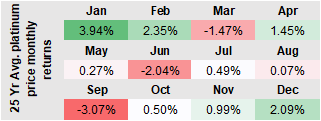
Fig 2. Seasonally weak first quarter platinum production underpins positive price performance
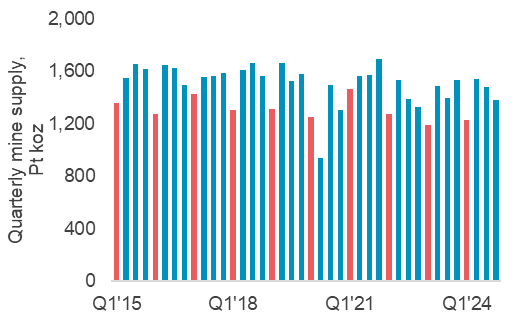
In combination with recent restructuring activities, mine supply should remain seasonally depressed in Q1 2025, likely supporting platinum prices.
This year, the automotive recycling value chain could compound seasonaility. We note that the WPIC’s intial annual recycled platinum supply forecasts for 2022 and 2023 (typically published in the preceding November) were subsequently lowered by 13% and 11% respectively as spent autocatalyst shortages emerged across the supply chain (Fig. 4). So far in 2024, quarterly recycled autocatalyst supply has been in the lower quartile of supply over the past ten-years (Fig. 5). However, Q4 2024f supply is forecast to increase by 32% QoQ, despite historic data showing no evidence of recycling typically picking up in the fourth quarter (other than during 2020 where pent up stock was released after COVID lockdowns). Should Q4 2024f mirror historic quarterly seasonality, full year 2024f supply could be ~50 koz lower. Similarly, the ongoing challenges facing recycling supply may put in question the forecast for recycling supply to increase by 12% YoY in 2025f. Should Q4’24 and Q1’25 recycling volumes fall short of expectations it could potentially accentuate platinum price seasonaility from December to February.
Platinum’s attraction as an investment asset arises from:
- WPIC research indicates that the platinum market entered a period of consecutive supply deficits from 2023 and these are expected to fully deplete above ground stocks by 2028f.
- Platinum supply remains challenged, both in terms of primary mining and secondary recycling supply.
- Platinum demand is benefitting from its use across a diverse set of end markets.
- Platinum is a critical mineral in the global energy transition underpinning a key role in the hydrogen economy.
- The platinum price remains historically undervalued and significantly below the price of gold.
Figure 3: Monthly returns for platinum price performance. The platinum price has exhibited strong seasonality over the past 25 years with compounded average returns of almost 7% for January and February combined.
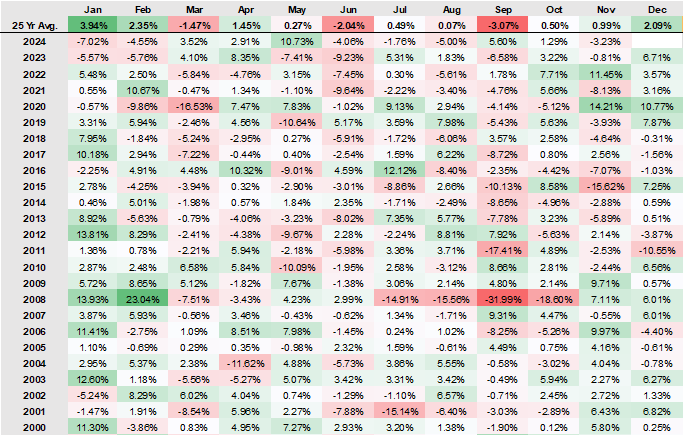
Figure 4: Persistent supply chain challenges have led to initial annual forecast for recycled platinum supply to be downgrade in 2022 and 2023
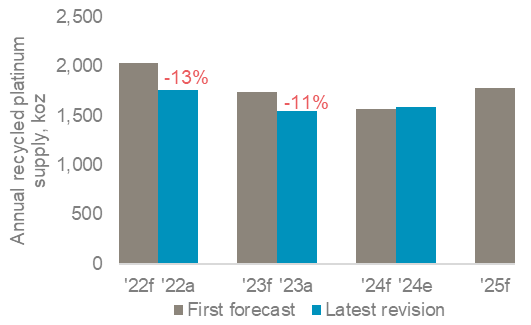
Figure 5: WPIC’s 2024f recycled platinum supply forecast relies on sharp quarterly growth in recycled autocatalyst supply in Q4 which has not historically been seasonally evident
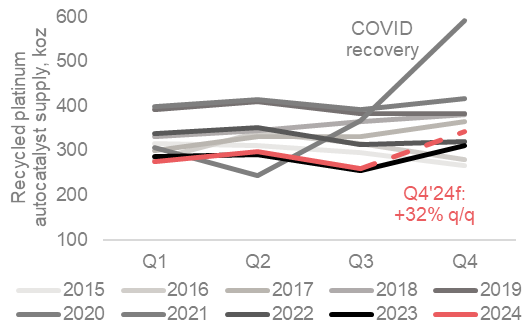
IMPORTANT NOTICE AND DISCLAIMER: This publication is general and solely for educational purposes. The publisher, The World Platinum Investment Council, has been formed by the world’s leading platinum producers to develop the market for platinum investment demand. Its mission is to stimulate investor demand for physical platinum through both actionable insights and targeted development: providing investors with the information to support informed decisions regarding platinum; working with financial institutions and market participants to develop products and channels that investors need.
This publication is not, and should not be construed to be, an offer to sell or a solicitation of an offer to buy any security. With this publication, the publisher does not intend to transmit any order for, arrange for, advise on, act as agent in relation to, or otherwise facilitate any transaction involving securities or commodities regardless of whether such are otherwise referenced in it. This publication is not intended to provide tax, legal, or investment advice and nothing in it should be construed as a recommendation to buy, sell, or hold any investment or security or to engage in any investment strategy or transaction. The publisher is not, and does not purport to be, a broker-dealer, a registered investment advisor, or otherwise registered under the laws of the United States or the United Kingdom, including under the Financial Services and Markets Act 2000 or Senior Managers and Certifications Regime or by the Financial Conduct Authority.
This publication is not, and should not be construed to be, personalized investment advice directed to or appropriate for any particular investor. Any investment should be made only after consulting a professional investment advisor. You are solely responsible for determining whether any investment, investment strategy, security or related transaction is appropriate for you based on your investment objectives, financial circumstances and risk tolerance. You should consult your business, legal, tax or accounting advisors regarding your specific business, legal or tax situation or circumstances.
The information on which this publication is based is believed to be reliable. Nevertheless, the publisher cannot guarantee the accuracy or completeness of the information. This publication contains forward-looking statements, including statements regarding expected continual growth of the industry. The publisher notes that statements contained in the publication that look forward in time, which include everything other than historical information, involve risks and uncertainties that may affect actual results. The logos, services marks and trademarks of the World Platinum Investment Council are owned exclusively by it. All other trademarks used in this publication are the property of their respective trademark holders. The publisher is not affiliated, connected, or associated with, and is not sponsored, approved, or originated by, the trademark holders unless otherwise stated. No claim is made by the publisher to any rights in any third-party trademarks
WPIC Research MiFID II Status
The World Platinum Investment Council -WPIC- has undertaken an internal and external review of its content and services for MiFID II. As a result, WPIC highlights the following to the recipients of its research services, and their Compliance/Legal departments:
WPIC research content falls clearly within the Minor Non-Monetary Benefit Category and can continue to be consumed by all asset managers free of charge. WPIC research can be freely shared across investment organisations.
- WPIC does not conduct any financial instrument execution business. WPIC does not have any market making, sales trading, trading or share dealing activity. (No possible inducement).
- WPIC content is disseminated widely and made available to all interested parties through a range of different channels, therefore qualifying as a “Minor Non-Monetary Benefit” under MiFID II (ESMA/FCA/AMF). WPIC research is made freely available through the WPIC website. WPIC does not have any permissioning requirements on research aggregation platforms.
- WPIC does not, and will not seek, any payment from consumers of our research services. WPIC makes it clear to institutional investors that it does not seek payment from them for our freely available content.
More detailed information is available on the WPIC website:
https://www.platinuminvestment.com/investment-research/mifid-ii
Contacts:
Edward Sterck, Research, [email protected]
Wade Napier, Research, [email protected]
Kaitlin Fitzpatrick-Spacey, Research, [email protected]
Brendan Clifford, Head of Institutional Distribution, [email protected]
WPIC does not provide investment advice.
Please see disclaimer for more information.
